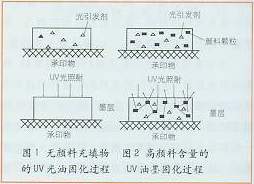UV inks were developed as far back as the 1940s, but they have not been developed until the last 20 years. The industry has also become more aware of UV inks. However, due to the higher price of UV inks, the large investment in drying equipment, and the use of a more complex process than conventional inks, these have hindered their wider application.
The trend of modern printing in the direction of rapid, multi-color one-time printing has also made new requirements for inks. Therefore, the advantages of UV inks are even more pronounced. For example, UV inks are not dried on the printing press and printed on the prints can be quickly dried, which not only meets the requirements for continuous printing in the printing factory, but also satisfies high speed. Multi-color printing machine requirements.
Effect of pigments on curing
In order to meet the high-end printing needs, it is not enough to rely on the three primary colors of ink, you need to use spot color inks, but for UV inks. Some pigment particles “grab†the incident UV radiation energy with photoinitiators or photosensitizers. Thus affecting the latter's absorption of radiant energy, so that the ultraviolet rays irradiating the surface of the UV ink can not be directly transmitted through, but only through multiple reflections and light scattering to bypass the above pigment particles to reach below the ink layer, slowing down the drying speed, Reduces drying efficiency.
Thousands of pigment particles are contained in the UV ink. Therefore, the UV light must have sufficient intensity to reach the bottom of the ink layer. If the light intensity is insufficient, the bottom of the ink layer will not be exposed to ultraviolet light. The ink cannot be completely cured, resulting in hard internal softness of the ink layer, and the surface wrinkles due to the volume shrinkage during polymerization, which affects the printing quality. At the same time, it should be noted that UV ink curing and UV varnish curing are different, as shown in Figure 1, Figure 2. Apart from affecting the curing of UV inks, pigments also affect the viscosity, fluidity, and wettability of the ink layer. Leveling and the like; and the interaction between the pigment and the reactive base material will also lead to ink storage period or color change and other issues.

Pigment color and curing
When using certain yellow pigments in photoinitiating systems composed of acrylates and amines, the color of the ink changes greatly. The more difficult to cure pigments are black and white. Phthalocyanine and yellow pigments. White and black show two extremes. White completely reflects light, and black does not reflect light at all.
It is even believed that it may not be possible to allow UV light to pass through a layer that has a certain thickness and is opaque to this light. However, optimizing the curing conditions will make it possible to cure UV inks containing pigments with some problems. It can be solved or improved by selecting the photoinitiator and the pigment according to the absorption characteristics of the pigment to UV light, and can also reduce the influence of the cured pigment by adjusting the UV light source.
Plush keychain,Stuffed Animals ,Dog Stuffed Animals ,Large Stuffed Animals
Plush & Stuffed Toy Co., Ltd. , http://www.nbplushtoy.com